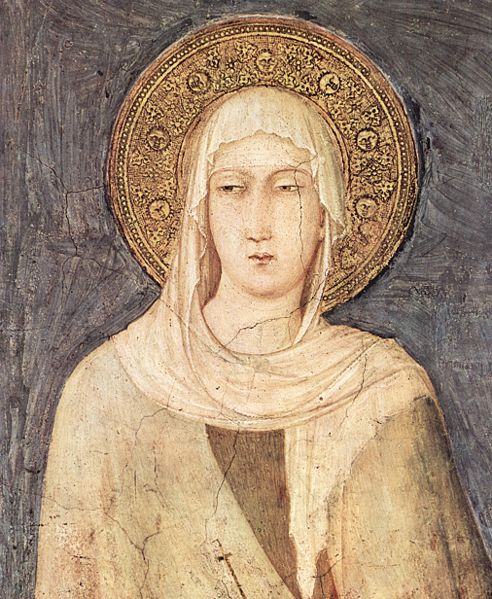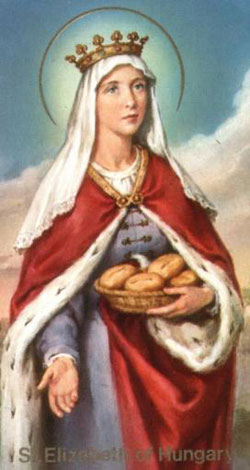I urge you again and again to practice true love and to aspire to truth and perfection, that you may satisfy God, please Him, and do Him honor and justice, first in Himself (God’s Presence) and then in the good people He loves and who love Him, and may you give them all they need whatever their state may be. This I urge you to do unceasingly, and this I have done since I came among you, for it is the best and most becoming way to serve God.- Hadewijch, 13th Century Beguine
We have been looking at the lives of Medieval Christian women. In previous weeks we saw that many women desired to follow in the footsteps of Jesus by serving the poor. Many sought a life of contemplation as well. The women were more or less educated depending on their circumstances. The church was beginning to develop theology by this time and the women’s lives were affected by it.
There were three forms of Medieval theology, two main types and a variation. There was scholasticism, primarily the scholasticism of Thomas Aquinas. This theology was considered the more intellectual theology and we find these theologians in the universities. The second group of theologians includes St. Benedict and others who wrote biblical theology from their perspective as monastics. They believed that their theology should come out of their fingertips and so we find them concerned with following Jesus by working among the poor. They were no less intelligent, they just expressed their theology in a different way.
There was another group of theologians during the thirteenth century who tried to make theology accessible to the people. This has been called vernacular theology. This theology is primarily distinguished from the others because it was written in the language of the common people. Anyone who could read could benefit from the writings of the pious men and women who put the Gospel and other instructions into their own tongue. The theological truths were the same; only accessibility changed.
Because university education was denied to women, very few could write in Latin, the official language of church and scholars. Some, like Hildegard of Bingen, taught themselves anyway. But most of the female religious taught or wrote in their own tongue. The people were glad to have something they could understand and so many of the mystics had large followings. This could create a problem for the jealous clerics. We should not be surprised to find that the church persecuted the Beguines and other female religious. Many Christian women were arrested and exiled or forced into cloisters. At least one (Marguerite Porete) was burned at the stake. Hadewijch, a very intelligent, self-taught woman wrote in the vernacular. One unique Beguine, Elizabeth of Spalbeek, related the Gospel in the form of live performances. The stories of these three women follows.
Hadewijch – (13th Century)
Historians have been unable to discover exact dates for Hadewijch’s birth and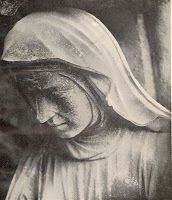 death. We do know that her writings were circulating between 1220 and 1240 so it seems reasonable to place her in mid-thirteenth century. Most of what we know has been deduced from Hadewijch’s writings.
death. We do know that her writings were circulating between 1220 and 1240 so it seems reasonable to place her in mid-thirteenth century. Most of what we know has been deduced from Hadewijch’s writings.
Hadewijch wrote in Middle Dutch, so perhaps she came from somewhere around Antwerp. She knew French, Latin, and Provençal, in addition to Dutch. Her knowledge of the Scriptures was formidable. She was also familiar with writers such as Saint Augustine, William of Saint Thierry, Richard of St. Victor, Bernard of Clairvaux and others of the mystical tradition. This education suggests that Hadewijch came from an aristocratic background.
She appears to have been a Beguine (see post July 27, 2016) and was perhaps the head mistress in a beguinage. She wrote extensively producing at least thirty-one letters, forty-five poems in stanzas, fourteen visions, and sixteen poems in couplets. Hadewijch is considered one of the most exquisite crafters of poems of “courtly love”. The “courtly love” literature was popular in the Middle Ages. One of the themes involved placing one’s love on a pedestal and striving to obtain the seemingly unreachable. Hadewijch used the themes but wrote hers as an expression of her longing for God.
Besides writing, Hadewijch spent most of her life helping the poor, the elderly, the ill and the neglected. Her writings exhort her sister Beguines to follow her example by engaging in prayer, contemplation and charitable works. (See quote at top of this post.) Her writing also reveals her strong belief in the importance of community and relationships in the community. Through it all is expressed a belief in the Trinity and devotion to the Lord Jesus Christ.
Scholars surmise that toward the end of her life Hadewijch was evicted from her beguinage and forced into exile. Reasons are unclear, but in one of her letters she expresses her longing to be with her sisters again. It is sad, but we do not know any more of Hadewijch’s life or death. I look forward to finding out more in Heaven!
Today, Hadewijch’s writings are considered to be among the masterpieces of literature from the Low Countries. You can find many of her beautiful poems online.
Marguerite Porete (1250-1310)
Like Hadewijch, most of what we know of Marguerite of Porete comes from her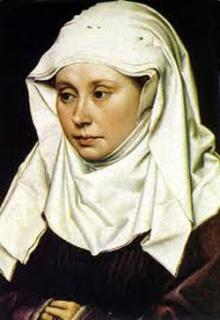 writing. It seems that she was a Beguine and was either a solitary itinerant or belonged to a small community.
writing. It seems that she was a Beguine and was either a solitary itinerant or belonged to a small community.
By the late thirteenth century the church was persecuting the Beguines because of their independent attitude. Unfortunately for Marguerite, the church made an extreme example of her, condemning her and burning her at the stake.
Marguerite had written a book, The Mirror of Simple Souls, that the church banned and burned. Some of Marguerite’s mystical views seem very far out (such as her ‘mystical union of our will with the will of God’). We have seen that the mystics had a wide range of views from very unbiblical to very Scriptural. Yes, some of Marguerite’s views seem strange to us, but other mystics were even stranger and they did not get burned at the stake. Why did Marguerite get treated so severely?
There were several reasons. For one thing, Marguerite was the victim of politics. It seems that Marguerite was an easy target for Philip IV who was busy trying to prove to the pope that he was a defender of the Catholic faith. The French king Philip the “Fair” held an inquisition against heretics and Marguerite was the first one to be condemned to death by burning at the stake.
Secondly, it seems that Marguerite’s real crime was in writing The Mirror of Simple Souls in the vernacular rather than in Latin, and it had a popular following. Religious authorities did not like it when someone claimed that their authority to write or teach came directly from God and not the church hierarchy; the theological elite wanted control over all teaching and told Marguerite to stop. Marguerite continued to teach so she was arrested in 1309, put on trial and burned at the stake on June 1, 1310.
Though church officials tried to destroy every copy, The Mirror of Simple Souls did not get completely incinerated at the hands of Marguerite’s inquisitors. It is hard to see why a mystical story written in a popular literary style should be such a threat to the church. The book is an allegory in which characters have conversations about love and theology. Marguerite ‘s surrender to Christ and her piety come through. Thankfully, seven hundred years later Christians can still read this poetical masterpiece.
Elizabeth of Spalbeek (1246-1304)
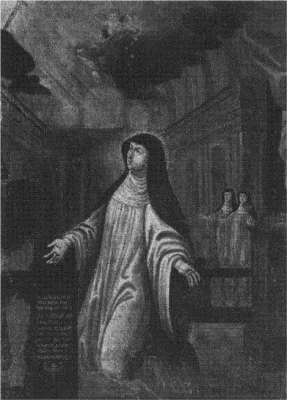 During the Middle Ages dramatic performances were used to educate and to entertain. Miracle plays, morality plays, and stories from the Bible were very popular. One favorite was a re-enactment of Christ’s Passion and Crucifixion.
During the Middle Ages dramatic performances were used to educate and to entertain. Miracle plays, morality plays, and stories from the Bible were very popular. One favorite was a re-enactment of Christ’s Passion and Crucifixion.
Since women were forbidden to preach from a pulpit they looked for other ways to share the Gospel. Many turned to drama as the medium to share the story of Jesus. One of the most well-known was Elizabeth of Spalbeek.
Some of what is known about Elizabeth comes from a “vitae” (life story) written by one Philip of Clairvaux, an abbot at a Cistercian monastery. Philip wrote a report on Elizabeth’s reported miracles and her stigmata. Hers was the first documented case of a stigmata after Francis of Assisi. Though this phenomenon was and is still questionable, it was a part of Elizabeth’s story.
Elizabeth was born into a noble family in the village of Spalbeek in Belgium. She lived most of her life in a cell in a local chapel with a large window looking out to the altar. Her performances of the Passion of Christ became very popular. She attracted audiences from far and wide. Besides her gift of performing, Elizabeth was also known for her ability to discern people’s problems and give spiritual counsel.
The goal of Elizabeth’s teaching was the reform of the clergy. As mentioned before in other stories on tis blog site, the clergy had become lazy and indulgent. Elizabeth challenged her audience, especially the priests, to try and understand what Jesus suffered for them. She advocated for more gratitude in the priests’ preaching. Abbot Philip understood her. He said, “she teaches faith in the Passion; in her joy and cheerfulness after pain, she teaches faith in the Resurrection; … faith in the mission of the Holy Ghost… her desire for the salvation of all and … her sorrow over humanity’s ingratitude and loss of absolution.” The audience should be moved to “strength of faith and to love of charity and to practice of devotion!”
These three women, Hadewijch, Marguerite, and Elizabeth were Beguines and lived their lives in service to Christ and to those around them. They all strived to communicate Christ’s love, two by writing and one by performing plays. They all taught in the language of the people so many thousands were touched by their ministries.
These mystics lived during a time period that is very unfamiliar. I encourage readers to look up their stories and their writings to enrich their own knowledge of history. You will be blessed!
But a little warning – These women, especially Marguerite had “visions” and “dreams” that were questionable. I believe that we should take the good part from their lives of service as our example. Whether their visions were from God, their own imaginations, or the devil, I prefer to be cautious but considerate.
